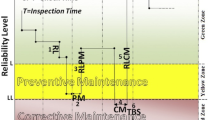Abstract
Real-time adaptive production control in the flexible manufacturing cell (FMC) is a complex issue that needs to be addressed to realize good performance and high productivity. In this paper, we have considered a support vector machine (SVM)-based simulation approach to resolve a production control problem in an FMC that operates in a dynamic environment. A SVM-based simulation approach chooses the most relevant scheduling rule out of several predefined ones on the basis of the current states of the system. This paper examines and compares the performance of the SVM-based simulation approach with the competent scheduling rules under two different operational environments which are characterized by the uncertainty of demand. We have also developed a Visual Basic-based simulation approach for scheduling of component parts in the context of FMC under different situations. The SVM methodology to control the production offers better performance than the single-rule-based production control system.
Similar content being viewed by others
References
Stecke KE, Solberg JJ (1981) Loading and control policies for a flexible manufacturing system. Int J Prod Res 19(5):481–490
Arzi Y, Iaroslavitz L (2000) Operating an FMC by a decision-tree-based adaptive production control system. Int J Prod Res 38(3):675–697
Arzi Y, Iaroslavitz L (1999) Neural network-based adaptive production control system for a flexible manufacturing cell under a random environment. IIE Trans 31(3):217–230
Slomp J, Gaalman GJC, Nawijn VM (1988) Quasi online scheduling procedures for flexible manufacturing systems. Int J Prod Res 26(4):585–598
Hutchinson J, Leoong K, Snyder D, Ward P (1991) Scheduling approaches for random job shop flexible manufacturing systems. Int J Prod Res 29(5):1053–1067
Lin GY, Solberg JJ (1991) Integrated shop floor control using autonomous agents. IIE Trans 24(3):57–71
Shaw MJ, Park S, Raman N (1992) Intelligent scheduling with machine learning capabilities: the induction of scheduling knowledge. IIE Trans 24(2):156–169
Montazeri M, VanWassenhove LN (1991) Analysis of scheduling for an FMS. Int J Prod Res 28(4):785–802
Arzi Y, David R (1998) Dispatching in a workshop belonging to a re-entrant production line under sequence dependent set-up times. Prod Plan Contr 9(7):690–699
Piramuthu S, Raman N, Shaw MJ (1994) Learning-based scheduling in a flexible manufacturing flow line. IEEE Trans Eng Manage 41(2):172–182
Shinichi N, Taketoshi Y (1992) Dynamic scheduling system utilizing matching learning as a knowledge acquisition tool. Int J Prod Res 30(2):411–431
Arzi Y, Roll Y (1993) Dispatching procedures for a flexible manufacturing cell in constant production circumstance. Int J Oper Prod Manage 13(2):35–51
Babak S, Madhavi I, Solimanpur M (2010) Development of a simulation-based intelligent decision support system for the adaptive real-time control of flexible manufacturing systems. J Soft Eng and App 3(7):661–673
Zhibin J, Richard FYK (2003) An adaptive agile manufacturing control infrastructure based on TOPNs-CS modeling. Int J Adv Manuf Technol 22(3–4):191–215
Ottaway TA, Burns JR (2000) An adaptive production control system utilizing agent technology. Int J Prod Res 38(4):721–737
Li W, Luo X, Tu Y (2011) A heuristic for adaptive production scheduling and control in flowshop production. Int J Prod Res 49(11):3151–3170
Yeou R, Ruey S (2006) The optimization of attribute selection in decision tree-based production control systems. Int J Adv Manuf Technol 28(7):737–746
Shiue YR, Su CT (2002) An enhanced knowledge representation for decision-tree based learning adaptive scheduling. Int J Adv Manu Technol 16(1):48–60
Corts C, Vapnik VN (1995) Support vector networks. Mach Learn 20:273–297
Buzacott JA, Yao DD (1986) Flexible manufacturing systems: a review of analytical models. Manag Sci 32(7):890–905
Friedman J (1996) Another approach to polychotomous classification, Technical report, Stanford University
Author information
Authors and Affiliations
Corresponding author
Rights and permissions
About this article
Cite this article
Manupati, V.K., Anand, R., Thakkar, J.J. et al. Adaptive production control system for a flexible manufacturing cell using support vector machine-based approach. Int J Adv Manuf Technol 67, 969–981 (2013). https://doi.org/10.1007/s00170-012-4541-1
Received:
Accepted:
Published:
Issue Date:
DOI: https://doi.org/10.1007/s00170-012-4541-1




